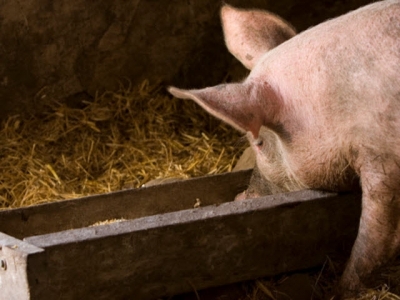Diet quality, supplement combinations, later weaning may boost development in pigs

Pelleted, easily digestible feed, deeper understanding of supplement combinations and later weaning may be among the keys for better nutritional intake and growth in young pigs, researchers say.
Many pork producers, nutritionists and veterinarians are trying to find systems or practices to replace the use of medically important antibiotics in growth promotion and health maintenance, said Gerald Shurson, extension specialist and professor of swine nutrition at the University of Minnesota.
However, there can be a “laundry list” of tools and practices to help support adequate nutritional intake and boost health and production, he told FeedNavigator. These include steps from ensuring good hygiene in nursery facilities to use of additives in post-weaning feed.
Feed composition
“Their digestive enzyme development isn’t quite ready to take on corn or soybean meal,” said Shurson of newly weaned pigs. “Those early weaning diets need to contain specialized, highly digestible ingredients.” The ingredients could include items like fishmeal, spray dried porcine plasma or bovine plasma, he added.
Additionally, adding days before weaning can help with piglet development, he said.
“The trend has migrated back to a 21 day weaning, but some do it at 18 days, or 19 days and it can make a pretty big difference in the amount of stress they go through,” said Shurson. “At slightly older ages mortality rates are less, and performance is better.”
Another way to meet the nutritional needs of just-weaned piglets is to feed small amounts of an energy dense feed they can digest, he said. And to pellet the product to keep feed ingredients in the proper proportions.
Niche market suggestions and requirements
For pig producers within the niche markets, either those based on breed-specific production or “social or credence attributes,” like pigs raised without antibiotics or growth promotors, pasture-raised, fed only vegetarian or organic diets, there may be additional best practices, said Mark Honeyman, coordinator of the Iowa State University research farms and professor of animal science.
For many of the piglets raised through alternative systems, the primary nutrition they receive comes from the sow as weaning is much later, he said. Weaning often happens at four to six weeks and older pigs are better prepared to digest plant-based proteins.
“The biggest thing that takes [supplements’] place is sow’s milk,” he said. “The other things that take their place would be whey, if that’s possible, that’s a byproduct from cheese making, and soybean meal or fishmeal – those are all high quality protein sources that young pigs need.”
Young pigs remain sensitives to digestive problems, he said, which can result in diarrhea and scours. Preventative measures include offering feeds that include rolled oats, feeding small amounts multiple times and minimizing stress with practices like group lactation.
However, there isn’t much that can be added to a sow’s diet to improve the nutritional intake of the piglets, he said. The primary intent is to make sure the sow has enough feed to maintain energy levels and a high rate of lactation.
Supplements use
Additionally, there are a plethora of supplements including prebiotics, probiotics, acidifiers, zinc oxide and copper oxide at supra-nutritional levels, available that can be given to young piglets to boost early production, said Shurson.
Questions also are being asked about fiber as it can offer benefits to gut health, especially when used in conjunction with enzymes, he said.
The microbiome of a pig’s intestinal tract is not fully understood, he added.
Future research’s “holy grail”
Shurson said his research team hopes to start conducting research on the interaction between different additive products when they are used in conjunction. Many of the compounds have different “modes of action” that, when combined, may enhance piglet health and growth performance above the individual additive abilities.
“In order to use these antibiotic alternatives strategically and effectively, we need to have a better understanding of how they affect the pigs when they’re added to the feed,” he said. “By understanding the mechanisms, we can then start to pair them up, or look at combinations of them that have by themselves effects, but, in combination with other components, further enhance feed and growth of the pigs.”
Previously, most research into growth promoting additives examined specific responses, which may not have provided a complete picture of how the compounds work, he said. Adding, “When growth rate, feed intake, and feed efficiency are the only response criteria used, it is difficult to explain why many of these compounds provided positive growth responses in some trials, and no response in other trials.”
“Using a systems biology approach with modern analytical techniques to understand the mechanisms, to me, is the holy grail of using these products more strategically and effectively,” he said. “When we’re faced with this laundry list of compounds and you have so many choices the question is, ‘What should I pick, and what should I combine?’ That’s where a lot of veterinarians, nutritionists and producers are now.”
Có thể bạn quan tâm
Phần mềm

Phối trộn thức ăn chăn nuôi

Pha dung dịch thủy canh

Định mức cho tôm ăn

Phối trộn phân bón NPK

Xác định tỷ lệ tôm sống

Chuyển đổi đơn vị phân bón

Xác định công suất sục khí

Chuyển đổi đơn vị tôm

Tính diện tích nhà kính

Tính thể tích ao hồ



 Protein amount, not source may guide antibiotic-free swine…
Protein amount, not source may guide antibiotic-free swine…  Researchers question efficacy of low-protein, high-fiber diets on…
Researchers question efficacy of low-protein, high-fiber diets on…